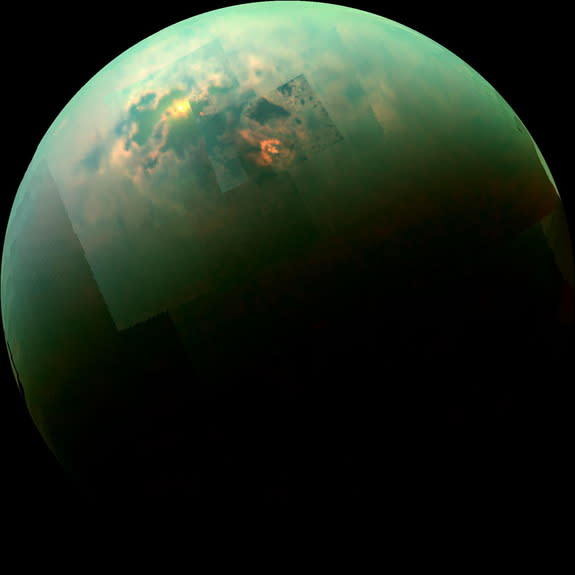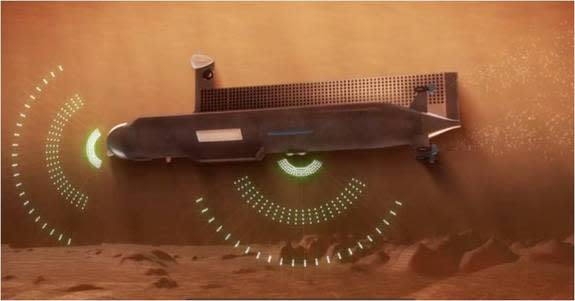NASA Space Submarine Could Explore Titan's Methane Seas
COCOA BEACH, Fla. — The extraterrestrial seas of Titan, Saturn's largest moon, provide an ideal world for a robotic submarine to explore, and a team of scientists is working on an innovative mission concept that could make that vision a reality.
A submarine on Titan would open up the lakes and rivers of liquid methane and ethane that cover the cloudy Saturn moon to exploration. In a NASA video of the Titan Sub mission concept, the robotic submarine sails the Kraken Mare, the largest northern sea on Titan. That alien sea is nearly 600 miles (1,000 kilometers) wide and 1,000 feet deep (300 meters).
According to the mission design, the Titan submarine would use science instruments to probe a full spectrum of oceanographic phenomena. These tasks would include measuring the chemical composition of the sea, mapping surface and subsurface currents, and making a detailed inspection of bottom features. [Amazing Photos of Titan by NASA's Cassini]
The concept was detailed during the NASA Innovative Advanced Concepts 2015 symposium, held here Jan. 27-29. NIAC sponsors cutting-edge, innovative and technically credible advanced concepts under the auspices of the Space Technology Mission Directorate at NASA Headquarters in Washington, D.C.
A submarine on Titan
First of all, if you're going to explore Titan, why a submarine?
Such a vehicle provides a more efficient, on-the-spot science system, said Steven Oleson, lead of NASA's Collaborative Modeling for Parametric Assessment of Space Systems (COMPASS) conceptual spacecraft design team at Glenn Research Center in Cleveland, Ohio.
The sub approach makes the vessel both highly maneuverable and capable of very long-range duties, similar to autonomous underwater vehicles here on Earth, Oleson said.
The ethane and methane seas on Titan have been extensively mapped by NASA's Cassini spacecraft, which has been studying the moon as part of its mission to Saturn since 2004, when the probe arrived in orbit around the ringed planet. In January 2005, the Huygens probe — a lander carried by Cassini, but built by the European and Italian space agencies — landed on the surface of Titan, beaming back the first photos of that strange new world.
But what's beneath the surface of Titan's seas remains an enigma — one that a submarine could help solve, Oleson and his team members say.
The COMPASS team scoped out the submarine idea along with technologists and scientists from The Johns Hopkins Applied Physics Laboratory (JHUAPL) in Laurel, Maryland, and submarine designers from The Pennsylvania State University's Applied Research Laboratory.
Oleson told Space.com that the NIAC-funded first-look focused on just the submarine. Follow-on study money, if awarded, would entail research into a delivery system to plop the vessel into Titan's seas. The team initially assumed a lifting-body spacecraft could be used, he said, but they may also consider an inflatable aeroshell or a simple, extended, shaped aeroshell to deploy the long, skinny sub on the Saturn moon.
Sailing an extraterrestrial sea
Once down on Titan, the roughly 3,000-lb. (1,400 kilograms) submarine would be powered by two Stirling radioisotope generators, which generate electricity from heat produced by a slug of radioactive plutonium. The submersible would then use waste-heat-fluid loops to keep the craft's insides nice and warm.
Capable of topside surveying as well as undersea sleuthing, the vessel would tote a meteorology sensor, a light and camera system, sun sensors, a physical properties package, a depth sounder, sample-acquisition gear, and side-scan sonar arrays. Antennas on each side of the sub would allow for surface sailing while maintaining communication back to Earth, either directly or via an orbiter.
The team has blueprinted a unique ballast system that would permit the sub to repeatedly deep-dive and resurface over months of operation on Titan.
A "cruise day" for the Titan submarine would involve eight hours of submerged science and 16 hours of surfaced shore imaging and gathering of meteorological data. [Titan, Saturn's Largest Moon, Unmasked (Infographic)]
"This submarine study is just the latest of many possibilities considered to explore Titan, which is such a rich environment to explore, in many ways similar to Earth," said Ralph Lorenz, a space scientist at JHUAPL.
Target: Titan
Lorenz told Space.com that the last few years have seen a surge in interest in Titan's seas. "Only Titan and Earth have open bodies of liquid like this," he said.
Regarding the submersible for Titan, Lorenz said that there are only modest differences between making such a submarine work on Titan and making a regular research ship work.
"Once you develop the delivery system, the autonomy, the instruments and communication, and propulsion to sail wherever you want to go on the surface, buoyancy control is really the only major addition for a submersible," Lorenz said.\
A research ship for other worlds
A submersible can do everything a research ship can, Lorenz said, like visit specified locations in Kraken Mare, measure the currents and waves, and see the shoreline.
"But it opens up the third dimension. There may, for example, be layering in Titan's seas, much like in some of Earth's oceans and lakes, with different compositions, temperatures and turbidity" at different altitudes, Lorenz said. "You could, in principle, lower some sort of instrument package from a boat, but once you start worrying about winches and snagging and thermal management … in many ways, it is easier to just move the whole vehicle up and down through the 'water column,'" he said.
Lorenz said that a submarine is better for high-resolution inspection of the seabed. And seafloor sediments likely have some of the most interesting material on Titan, bearing a record of Titan's complex climate history.
By addressing the challenges of autonomous submersible exploration in a cold, outer-solar-system environment, the team's NIAC report said Titan Sub would serve as a pathfinder for even more exotic future exploration of other subsurface water oceans, such as those on Jupiter's moon Europa, which is a prime candidate for life elsewhere in the solar system.
Leonard David has been reporting on the space industry for more than five decades. He is former director of research for the National Commission on Space and is co-author of Buzz Aldrin's 2013 book "Mission to Mars – My Vision for Space Exploration" published by National Geographic with a new updated paperback version to be released this May. Follow us @Spacedotcom, Facebook and Google+. Original article on Space.com.
Copyright 2015 SPACE.com, a Purch company. All rights reserved. This material may not be published, broadcast, rewritten or redistributed.

 Yahoo News
Yahoo News 



